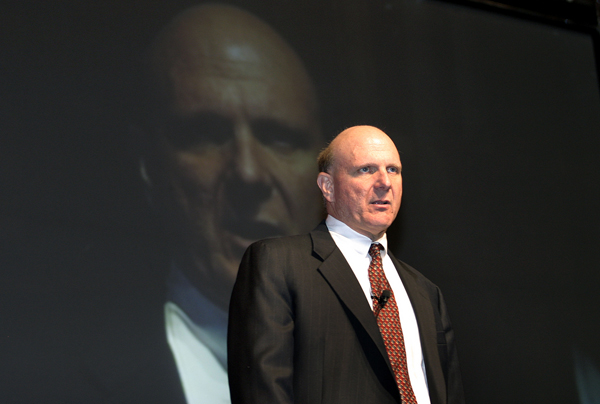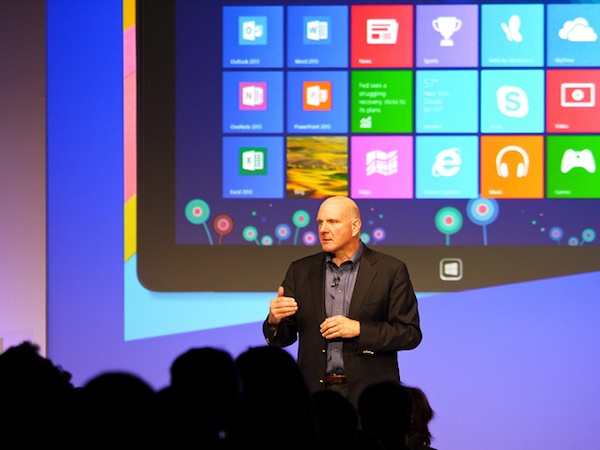Is CEO Steve Ballmer Microsoft’s Biggest Problem?


If Microsoft is to reclaim its Nineties glory, chief executive Steve Ballmer needs to go, according to a new book written by a former Microsoft senior executive. Not only does Ballmer force any rising manager who may challenge his authority out of the company, but the corporation has missed major technological opportunities under his leadership, claims Joachim Kempin, who worked for Gates & Co. from 1983 until 2002, in his new book, “Resolve and Fortitude: Microsoft’s ‘secret power broker’ breaks his silence.”
“For Microsoft to really get back in the game seriously, you need a big change of management,” Kempin told Reuters. “As much as I respect Steve Ballmer, he may be part of that in the end.”
Ballmer’s history with Microsoft goes back to the early days of the company. In 1980 co-founders Bill Gates and Paul Allen decided they possessed neither the business skills nor the management savvy to handle Microsoft’s newest contract with IBM. Gates brought in Ballmer—a friend from his Harvard days—to handle the business side of Microsoft.
In his 2011 book, “Idea Man,” Allen recalled his first meeting with Ballmer: “I thought, ‘This guy looks like an operative for the NKVD. He had piercing blue eyes and genuine toughness.”
The next 15 years or so are now a part of tech history as Microsoft’s Windows and Office products made it the company no other could touch. That is, until it wasn’t. Even Microsoft didn’t escape unscathed from the Dotcom crash at the end of the last millennium. In fact, on Dec. 30, 1999, Microsoft stock hit its pre-split all-time high of $119.94. Then it started to fall. Sixteen days later, Gates stepped down as CEO and handed the reins to Ballmer. One year later, Microsoft’s stock was worth half its 1999 value.
“I was stunned when Bill announced that he was stepping aside to become ‘chief software architect’ in January 2000, with Steve Ballmer succeeding him as CEO,” recalled Allen. “While Steve had long served as Bill’s top lieutenant, you got the sense through the Nineties that he wasn’t necessarily being groomed for Microsoft’s top spot. I’d say that Bill viewed him as a very smart executive with less affinity for technology than for the business side—that Steve just wasn’t a ‘product guy.’”
Microsoft never recovered. Today its stock barely tops $27 a share and has hardly exceeded $30 in the past year. Kempin says Ballmer’s management style is largely to blame. Insecure in his seat at the top, the CEO is quick to oust any promising executives who show potential to one day challenge him for his seat. Kempin cites former Hewlett-Packard executive Richard Belluzzo as an example. After leading the successful launch of the Xbox console and rising to chief operating office, Belluzo left Microsoft.
“He (Belluzzo) had no room to breathe on the top. When you work that directly with Ballmer and Ballmer believes ‘maybe this guy could someday take over from me’, my God, you will have less air to breathe, that’s what it comes down to,” Kempin told Reuters. “It was Steve’s way or the highway.”

In chasing away some of technology’s great minds in favor of a series of suits, Ballmer has crippled Microsoft’s once-genius think tank.
“By the dawn of the millennium, the hallways at Microsoft were no longer home to barefoot programmers in Hawaiian shirts working through nights and weekends toward a common goal of excellence; instead, life behind the thick corporate walls had become staid and brutish. Fiefdoms had taken root, and a mastery of internal politics emerged as key to career success,” Vanity Fair’s Kurt Eichenwald wrote in 2011.
Kempin’s book agrees with Eichenwald’s summary. In his writings, he explains how Microsoft foresaw many of the past decade’s technological advancements, but failed to launch successful products ahead of and in comparison to competitors such as Apple.
“They missed all the opportunities they were talking about when I was still in the company. Tablets, phones…we had a tablet going, we had tablet software when Windows XP came out, it was never followed up properly,” said Kempin. “Just think about the insult of Microsoft coming out with a tablet themselves, trying to mimic Apple, and now they are going to come out with a notebook on top of it.”
A prime example of Ballmer’s lack of vision? A would-be product code-named Courier, described by Gizmodo in 2009. A blogger named Paperboy called the device “an astonishing take on the tablet,” with its icon-rich user interface and multi-touch stylus-friendly screens. About the same time Apple’s forthcoming tablet was all the gossip among techies, Paperboy wrote, “Maybe we’ve all been dreaming about the wrong device.”
What happened? According to CNN, when Microsoft’s head of entertainment and devices presented the idea to Ballmer requesting additional funding for the project, Ballmer killed the project, explaining he felt the device was unnecessary.
“To some longtime Microsoft veterans, Ballmer’s swift termination of Courier symbolizes a shortsightedness that has plagued the company’s top management in recent years—and has left the company eating Apple’s dust,” CNN’s Gary Rivlin wrote.
Once the golden share to own, Microsoft’s entire line of products now sell less each year than the iPhone. Yes, one Apple product that didn’t exist some six years ago had higher annual sales in 2011 than everything Microsoft offered—including Windows, Office, Xbox, Bing, Windows Phone and every other product created since 1975. According to Vanity Fair, in the first quarter of 2012 iPhone sales totaled $22.7 billion, while Microsoft Corporation grossed $17.4 billion.
“I see Microsoft as technology’s answer to Sears,” Kurt Massey, a former senior marketing manager, told Vanity Fair. “In the 40s, 50s, and 60s, Sears had it nailed. It was top-notch, but now it’s just a barren wasteland. And that’s Microsoft. The company just isn’t cool anymore.”
Kempin agrees with Vanity Vair’s synopsis. He believes Microsoft needs a leader who is, perhaps, 35 to 40 years old—a younger person who understands the Facebook generation.
“Is he a great CEO? I don’t think so. Microsoft’s board is a lame duck board, has been forever. They hire people to help them administer the company, but not to lead the company. That’s the problem,” Kempin told Reuters. “They don’t need this guy on stage with this fierce, aggressive look, announcing the next version of Windows and thinking he can score with that.”
[1st Image via imagemaker/Shutterstock]
[2nd Image via Dell’s Official Flickr Page/Flickr]









































